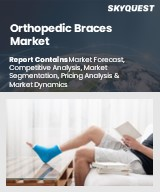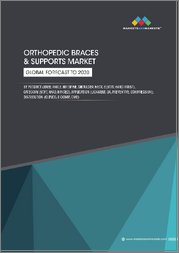
|
시장보고서
상품코드
1476438
석고 및 부목 시장 예측(-2030년) : 제품 유형, 용도, 최종사용자, 지역별 세계 분석Casting and Splinting Market Forecasts to 2030 - Global Analysis By Product Type (Casting and Splinting), Application, End User and By Geography |
||||||
Stratistics MRC에 따르면, 석고 및 부목 세계 시장은 2023년 28억 달러 규모이며, 예측 기간 동안 8.7%의 CAGR로 성장하여 2030년에는 51억 달러에 달할 것으로 예상됩니다.
석고 및 부목은 부상당한 뼈와 연조직을 고정하고 지지하는 데 사용되는 정형외과 기술입니다. 석고는 일반적으로 유리섬유 또는 석고로 만들어져 부상 부위를 완전히 감싸고 단단히 안정화시킵니다. 부목은 금속이나 유리섬유와 같은 재료로 만들어져 더 유연하며 일시적인 지원이나 경미한 골절에 자주 사용됩니다. 두 가지 방법 모두 치유를 촉진하고 통증을 완화하며 움직임을 제한하여 추가 손상을 방지하는 것을 목표로 합니다. 훈련된 전문가에 의한 적절한 착용은 효과를 보장하고 합병증을 최소화하기 위해 매우 중요합니다. 성공적인 재활을 위해서는 부종과 불편감 모니터링을 포함한 후속 치료가 필수적입니다.
세계보건기구(WHO)에 따르면, 인도는 전 세계 교통사고 사망자의 11%를 차지하고 있으며, 교통사고로 인한 부상은 인도에서 8번째로 높은 사망원인을 차지하고 있습니다.
골절 및 관절 손상의 증가
부상자 수가 증가함에 따라 보다 고급스럽고 전문적인 깁스 및 부목 재료에 대한 요구가 증가하고 있습니다. 이는 시장의 혁신을 촉진하여 환자의 편안함을 향상시키는 가볍고 편안한 소재, 치유 중 위생과 기능성을 향상시키는 방수 석고, 움직임 제어 및 재활을 가능하게 하는 조절 가능한 부목과 같은 새로운 제품을 개발하게 되었습니다. 이처럼 부상의 범위가 넓어짐에 따라 특정 요구사항에 대한 대응이 요구되고 있습니다. 따라서 손목, 발목 또는 특정 고정 기술이 필요한 복잡한 골절에 특화된 부목이 개발되기도 합니다.
높은 비용
높은 비용으로 인해 가능한 한 깁스 및 부목에 대한 비용 효율적인 대안을 찾는 데 중점을 둘 수 있습니다. 따라서 부목을 필요로 하지 않는 보조기나 물리치료 기법의 사용이 증가하여 깁스 및 부목 제품의 시장 규모가 전반적으로 축소될 수 있습니다. 이는 안전성에 대한 우려를 불러일으키고 혁신적인 신소재 개발을 저해할 수 있습니다.
노령인구의 증가
노년층이 되면 뼈가 약해져 작은 낙상에도 쉽게 골절되는 골다공증에 걸리기 쉽습니다. 따라서 골절이 치유되는 동안 골절을 고정하고 지지하기 위한 깁스나 부목의 필요성이 현저하게 증가합니다. 노화에 따른 균형과 협응력 감소는 특히 노년층의 낙상 및 부상 빈도를 증가시킵니다. 이러한 낙상은 허리, 손목, 발목 골절의 원인이 될 수 있으며, 적절한 치유를 위해 깁스나 부목이 필요합니다.
합병증의 위험성
감염이나 부적절한 치유와 같은 합병증으로 인해 추가 치료가 필요한 경우, 의료 비용이 크게 증가합니다. 이는 의료 예산을 압박하고 특정 상황에서 깁스 및 부목 사용에 대한 규제와 제한을 강화할 수 있습니다. 그 결과 의료 과실 보험 비용이 증가하여 의료 서비스 제공자가 깁스 및 부목 사용에 신중을 기하고 그 적용이 제한될 수 있습니다.
COVID-19의 영향
COVID-19 사태는 인도적, 경제적 위기로 부상하여 사회를 뒤흔들고 수백만 명의 사람들과 기업에 영향을 미치고 있습니다. 산업은 폐쇄되고 사람들은 집에서 생활해야 하며, 그 결과 자금과 경제 성장에 큰 타격을 입었습니다. 의료 기관은 이미 전투 태세에 돌입하여 신속 진단 키트 조달에서 작업자를 위한 충분한 PPE 키트에 이르기까지 증가하는 COVID-19 환자를 수용하기 위한 새로운 계획을 준비하고 있습니다. 의료 분야가 COVID-19 치료에 집중되면서 깁스 및 부목 관련 연구 및 개발 활동에 대한 자금이 감소하여 이 분야는 부주의에 직면하게 되었고, 그 결과 깁스 및 부목 시장에 부정적인 영향을 미치고 있습니다.
부목 분야는 예측 기간 동안 최대 규모가 될 것으로 예상됩니다.
부목은 경성 석고에 비해 다재다능하기 때문에 부목 분야는 유리한 성장을 할 것으로 추정됩니다. 부목은 부종에 대응하거나 치유 중 움직임을 제어할 수 있도록 조정할 수 있기 때문에 더 광범위한 근골격계 부상에 적합합니다. 따라서 깁스를 통한 완전한 고정이 필요한 부상 이외에도 대응할 수 있어 시장의 폭을 넓힐 수 있습니다.
예측 기간 동안 가장 높은 CAGR을 보일 것으로 예상되는 분야는 근골격계 손상 분야입니다.
골절, 염좌, 염좌, 변형, 탈구 등 근골격계 손상은 깁스나 부목이 필요한 주요 이유입니다. 이러한 부상의 높은 발생률은 깁스 및 부목이 제공하는 고정 및 지지력에 대한 높은 필요성과 직결됩니다. 이러한 수요 증가는 깁스 및 부목 시장 제조업체와 공급업체의 매출과 수익을 증가시키고 있습니다.
가장 큰 점유율을 차지하는 지역:
아시아태평양은 예측 기간 동안 가장 큰 시장 점유율을 차지할 것으로 예상됩니다. 이는 전 세계 노인 인구 증가, 응급 상황 및 교통 사고 사례 증가, 심각한 근골격계 부상으로 이어지는 모험 및 스포츠 활동 증가, 아시아태평양의 기술 채택률 증가 등의 요인으로 인해 아시아태평양의 시장을 주도하고 있습니다. 또한, 인도, 일본, 중국, 한국 등 인구 밀도가 높고 교통사고 및 정형외과적 손상 사례가 많은 국가들의 존재는 깁스 붕대 및 부목 도구 시장의 수요를 증가시키는 결과를 낳고 있습니다.
CAGR이 가장 높은 지역:
북미는 제조 시설의 수가 많고 저렴한 노동력을 이용할 수 있기 때문에 이러한 장비의 제조 비용을 낮게 유지하여 업계의 요구 사항을 충족하기 위해 저렴한 장비를 대량으로 제공하는 데 도움이 될 수 있습니다. 저렴한 비용으로 더 나은 건강 결과를 얻으려는 높은 긴장감과 인구 밀집 지역이 가까운 미래에 시장을 촉진하는 또 다른 요인입니다.
무료 맞춤형 서비스:
이 보고서를 구독하는 고객은 다음과 같은 무료 맞춤화 옵션 중 하나를 사용할 수 있습니다.
- 기업 개요
- 추가 시장 기업의 종합적인 프로파일링(최대 3개사까지)
- 주요 기업 SWOT 분석(최대 3개사)
- 지역 세분화
- 고객의 관심에 따른 주요 국가별 시장 추정치, 예측, CAGR(주: 타당성 검토에 따른)
- 경쟁사 벤치마킹
- 제품 포트폴리오, 지리적 입지, 전략적 제휴를 기반으로 한 주요 기업 벤치마킹
목차
제1장 주요 요약
제2장 서문
- 개요
- 이해관계자
- 조사 범위
- 조사 방법
- 데이터 마이닝
- 데이터 분석
- 데이터 검증
- 조사 접근법
- 조사 정보 출처
- 1차 조사 정보 출처
- 2차 조사 정보 출처
- 가정
제3장 시장 동향 분석
- 성장 촉진요인
- 성장 억제요인
- 기회
- 위협
- 제품 분석
- 용도 분석
- 최종사용자 분석
- 신흥 시장
- COVID-19의 영향
제4장 Porter's Five Forces 분석
- 공급 기업의 교섭력
- 구매자의 교섭력
- 대체품의 위협
- 신규 참여업체의 위협
- 경쟁 기업 간의 경쟁 관계
제5장 세계의 석고 및 부목 시장 : 제품 유형별
- 석고
- 파이버글라스 석고
- 플라스터 석고
- 폴리우레탄 석고
- 기타 석고 제품
- 부목
- 파이버글라스 부목
- 플라스터 부목
- 기타 부목 제품
제6장 세계의 석고 및 부목 시장 : 용도별
- 골절 관리
- 상지
- 하지
- 근골격계 손상
- 수근관증후군
- 염좌
- 건 장애
- 기타 근골격계 손상
제7장 세계의 석고 및 부목 시장 : 최종사용자별
- 병원
- 클리닉
- 재택 헬스케어
- 외래 수술 센터
제8장 세계의 석고 및 부목 시장 : 지역별
- 북미
- 미국
- 캐나다
- 멕시코
- 유럽
- 독일
- 영국
- 이탈리아
- 프랑스
- 스페인
- 기타 유럽
- 아시아태평양
- 일본
- 중국
- 인도
- 호주
- 뉴질랜드
- 한국
- 기타 아시아태평양
- 남미
- 아르헨티나
- 브라질
- 칠레
- 기타 남미
- 중동 및 아프리카
- 사우디아라비아
- 아랍에미리트
- 카타르
- 남아프리카공화국
- 기타 중동 및 아프리카
제9장 주요 발전
- 계약, 파트너십, 협업, 합작투자
- 인수와 합병
- 신제품 발매
- 사업 확대
- 기타 주요 전략
제10장 기업 개요
- 3M Company
- Alimed, Inc.
- Ascent Meditech Limited
- B. Braun Melsungen AG
- Bird & Cronin, Inc.
- BSN medical GmbH
- Corflex, Inc.
- DeRoyal Industries, Inc.
- DJO Global, Inc.
- Medtronic plc
- Orfit Industries NV
- Ossur hf.
- Ottobock SE & Co. KGaA
- Patterson Medical Holdings, Inc.
- Prime Medical, Inc.
- Remington Products
- Smith & Nephew plc
- Spencer Italia S.r.l.
- Stryker Corporation
- Zimmer Biomet Holdings, Inc.
According to Stratistics MRC, the Global Casting and Splinting Market is accounted for $2.8 billion in 2023 and is expected to reach $5.1 billion by 2030 growing at a CAGR of 8.7% during the forecast period. Casting and splinting are orthopedic techniques used to immobilize and support injured bones and soft tissues. A cast is typically made from fiberglass or plaster and encases the injured area completely, providing rigid stabilization. Splints, made from materials like metal or fiberglass, offer more flexibility and are often used for temporary support or minor fractures. Both methods aim to promote healing, reduce pain, and prevent further injury by restricting movement. Proper application by trained professionals is crucial to ensure effectiveness and minimize complications. Follow-up care, including monitoring for swelling and discomfort, is essential for successful rehabilitation.
According to the World Health Organization, India accounts for 11% of the global road accident deaths, and road traffic injuries are the eighth leading cause of death in India.
Market Dynamics:
Driver:
Rising incidence of bone fractures and joint injuries
As the number of injuries rise, there's a growing need for more advanced and specialized casting and splinting materials. This spurs innovation in the market, leading to the development of new products like lighter and more comfortable materials for improved patient experience, water-resistant casts for better hygiene and functionality during healing, Adjustable splints that allow for controlled movement and rehabilitation. Thus With a wider range of injuries, there's a demand for catering to specific needs. This can lead to the development of specialized splints for wrists, ankles, or even for complex fractures requiring specific immobilization techniques.
Restraint:
High cost
Due to the high costs, there might be a greater emphasis on finding cost-effective alternatives to casting and splinting whenever possible. This could lead to increased use of braces or physical therapy techniques that might not require splinting, potentially reducing the overall market size for casting and splinting products. This could result in safety concerns or hinder the development of innovative new splinting materials.
Opportunity:
Growing geriatric population
As people age, they become more susceptible to osteoporosis, a condition that weakens bones and makes them more prone to fractures even from minor falls. This significantly increases the need for casting and splinting to immobilize and support fractures during healing. Age-related decline in balance and coordination can lead to more frequent falls and injuries, especially among the elderly. These falls can cause bone fractures in the hips, wrists, and ankles, all requiring casting or splinting for proper healing.
Threat:
Risk of complications
Complications like infections or improper healing that necessitate additional treatment can significantly increase healthcare costs. This puts a strain on healthcare budgets and can lead to stricter regulations or limitations on the use of casting and splinting in certain situations. This can increase malpractice insurance costs and make healthcare providers more cautious in using casting and splinting, potentially limiting its application.
Covid-19 Impact
The COVID-19 pandemic has emerged as a humanitarian as well as economic crisis, creating strain on the society and affecting millions of people and businesses. Industry closures and people are asked to stay in their homes which have cause taken a huge toll in terms of money and economic growth. Healthcare organizations are already working in battle mode, preparing new plans to respond growing COVID-19 patients, right from sourcing rapid diagnosing kits to sufficient PPE kits for workers. Due to diversion of medical field towards treating COVID-19, the funding to R&D activities related to casting and splinting has been reduced and this segment have to face negligence subsequently causing negative impact on casting and splinting market.
The splinting segment is expected to be the largest during the forecast period
The splinting segment is estimated to have a lucrative growth, as splints offer more versatility compared to rigid casts. They can be adjusted to accommodate swelling or allow for controlled movement during healing, making them suitable for a wider range of musculoskeletal injuries. This expands the market reach by catering to injuries beyond those requiring complete immobilization with a cast.
The musculoskeletal injuries segment is expected to have the highest CAGR during the forecast period
The musculoskeletal injuries segment is anticipated to witness the highest CAGR growth during the forecast period, musculoskeletal injuries, including bone fractures, sprains, strains, and dislocations, are a major reason why casting and splinting are needed. A higher incidence of these injuries directly translates to a greater need for immobilization and support, which is what casts and splints provide. This increased demand fuels sales and revenue for manufacturers and suppliers in the casting and splinting market.
Region with largest share:
Asia Pacific is projected to hold the largest market share during the forecast period due to factors like rise in the global prevalence of geriatric populace, rising cases of emergencies and road accidents, growth in adventures and sports activities leading to severe musculoskeletal injuries and higher adoption of technology in the region is propelling the market in the Asia-Pacific segment. Additionally presence of densely populated states including India, Japan, China, and Korea having large number of cases of road accidents as well as orthopedic injuries that will result in boosting the demand for casting and splinting equipment market
Region with highest CAGR:
North America is projected to have the highest CAGR over the forecast period, owing to the high number of manufacturing facilities, availability of cheap labor helps to keep the manufacturing costs for these equipment low, which will help in providing affordable equipment in bulk quantities to meet the industry requirement. High strain to get better health outputs at lower costs and dense population base are the other factors fuelling the market in the near future.
Key players in the market
Some of the key players in the Casting and Splinting Market include 3M Company, Alimed, Inc., Ascent Meditech Limited, B. Braun Melsungen AG, Bird & Cronin, Inc., BSN medical GmbH, Corflex, Inc., DeRoyal Industries, Inc., DJO Global, Inc., Medtronic plc, Orfit Industries NV, Ossur hf., Ottobock SE & Co. KGaA, Patterson Medical Holdings, Inc., Prime Medical, Inc., Remington Products, Smith & Nephew plc, Spencer Italia S.r.l., Stryker Corporation and Zimmer Biomet Holdings, Inc.
Key Developments:
In April 2024, Smith+Nephew announces new evidence supporting ALLEVYN* LIFE Foam Dressing's role in pressure injury prevention. This novel mechanism of action further adds to our understanding of how multi-layer dressings such as ALLEVYN LIFE work when used prophylactically for PIP.1
In April 2024, 3M launches new Verify app to help tackle counterfeit personal protective equipment. Depending on the type of product, using a counterfeit product could put a person's safety at risk.
In March 2024, 3M introduces a world's first innovation to help redefine shipping and packaging. This new material called 3M(TM) Padded Automatable Curbside Recyclable (PACR) Mailer Material is capable of producing packages up to three times faster than manual packing
Product Types Covered:
- Casting
- Splinting
Applications Covered:
- Fracture Management
- Musculoskeletal Injuries
End Users Covered:
- Hospitals
- Clinics
- Home Healthcare
- Ambulatory Surgical Centers
Regions Covered:
- North America
- US
- Canada
- Mexico
- Europe
- Germany
- UK
- Italy
- France
- Spain
- Rest of Europe
- Asia Pacific
- Japan
- China
- India
- Australia
- New Zealand
- South Korea
- Rest of Asia Pacific
- South America
- Argentina
- Brazil
- Chile
- Rest of South America
- Middle East & Africa
- Saudi Arabia
- UAE
- Qatar
- South Africa
- Rest of Middle East & Africa
What our report offers:
- Market share assessments for the regional and country-level segments
- Strategic recommendations for the new entrants
- Covers Market data for the years 2021, 2022, 2023, 2026, and 2030
- Market Trends (Drivers, Constraints, Opportunities, Threats, Challenges, Investment Opportunities, and recommendations)
- Strategic recommendations in key business segments based on the market estimations
- Competitive landscaping mapping the key common trends
- Company profiling with detailed strategies, financials, and recent developments
- Supply chain trends mapping the latest technological advancements
Free Customization Offerings:
All the customers of this report will be entitled to receive one of the following free customization options:
- Company Profiling
- Comprehensive profiling of additional market players (up to 3)
- SWOT Analysis of key players (up to 3)
- Regional Segmentation
- Market estimations, Forecasts and CAGR of any prominent country as per the client's interest (Note: Depends on feasibility check)
- Competitive Benchmarking
- Benchmarking of key players based on product portfolio, geographical presence, and strategic alliances
Table of Contents
1 Executive Summary
2 Preface
- 2.1 Abstract
- 2.2 Stake Holders
- 2.3 Research Scope
- 2.4 Research Methodology
- 2.4.1 Data Mining
- 2.4.2 Data Analysis
- 2.4.3 Data Validation
- 2.4.4 Research Approach
- 2.5 Research Sources
- 2.5.1 Primary Research Sources
- 2.5.2 Secondary Research Sources
- 2.5.3 Assumptions
3 Market Trend Analysis
- 3.1 Introduction
- 3.2 Drivers
- 3.3 Restraints
- 3.4 Opportunities
- 3.5 Threats
- 3.6 Product Analysis
- 3.7 Application Analysis
- 3.8 End User Analysis
- 3.9 Emerging Markets
- 3.10 Impact of Covid-19
4 Porters Five Force Analysis
- 4.1 Bargaining power of suppliers
- 4.2 Bargaining power of buyers
- 4.3 Threat of substitutes
- 4.4 Threat of new entrants
- 4.5 Competitive rivalry
5 Global Casting and Splinting Market, By Product Type
- 5.1 Introduction
- 5.2 Casting
- 5.2.1 Fiberglass Casts
- 5.2.2 Plaster Casts
- 5.2.3 Polyurethane Casts
- 5.2.4 Other Casting Products
- 5.3 Splinting
- 5.3.1 Fiberglass Splints
- 5.3.2 Plaster Splints
- 5.3.3 Other Splinting Products
6 Global Casting and Splinting Market, By Application
- 6.1 Introduction
- 6.2 Fracture Management
- 6.2.1 Upper Extremities
- 6.2.2 Lower Extremities
- 6.3 Musculoskeletal Injuries
- 6.3.1 Carpal Tunnel Syndrome
- 6.3.2 Sprains
- 6.3.3 Tendinopathy
- 6.3.4 Other Musculoskeletal Injuries
7 Global Casting and Splinting Market, By End User
- 7.1 Introduction
- 7.2 Hospitals
- 7.3 Clinics
- 7.4 Home Healthcare
- 7.5 Ambulatory Surgical Centers
8 Global Casting and Splinting Market, By Geography
- 8.1 Introduction
- 8.2 North America
- 8.2.1 US
- 8.2.2 Canada
- 8.2.3 Mexico
- 8.3 Europe
- 8.3.1 Germany
- 8.3.2 UK
- 8.3.3 Italy
- 8.3.4 France
- 8.3.5 Spain
- 8.3.6 Rest of Europe
- 8.4 Asia Pacific
- 8.4.1 Japan
- 8.4.2 China
- 8.4.3 India
- 8.4.4 Australia
- 8.4.5 New Zealand
- 8.4.6 South Korea
- 8.4.7 Rest of Asia Pacific
- 8.5 South America
- 8.5.1 Argentina
- 8.5.2 Brazil
- 8.5.3 Chile
- 8.5.4 Rest of South America
- 8.6 Middle East & Africa
- 8.6.1 Saudi Arabia
- 8.6.2 UAE
- 8.6.3 Qatar
- 8.6.4 South Africa
- 8.6.5 Rest of Middle East & Africa
9 Key Developments
- 9.1 Agreements, Partnerships, Collaborations and Joint Ventures
- 9.2 Acquisitions & Mergers
- 9.3 New Product Launch
- 9.4 Expansions
- 9.5 Other Key Strategies
10 Company Profiling
- 10.1 3M Company
- 10.2 Alimed, Inc.
- 10.3 Ascent Meditech Limited
- 10.4 B. Braun Melsungen AG
- 10.5 Bird & Cronin, Inc.
- 10.6 BSN medical GmbH
- 10.7 Corflex, Inc.
- 10.8 DeRoyal Industries, Inc.
- 10.9 DJO Global, Inc.
- 10.10 Medtronic plc
- 10.11 Orfit Industries NV
- 10.12 Ossur hf.
- 10.13 Ottobock SE & Co. KGaA
- 10.14 Patterson Medical Holdings, Inc.
- 10.15 Prime Medical, Inc.
- 10.16 Remington Products
- 10.17 Smith & Nephew plc
- 10.18 Spencer Italia S.r.l.
- 10.19 Stryker Corporation
- 10.20 Zimmer Biomet Holdings, Inc.



















